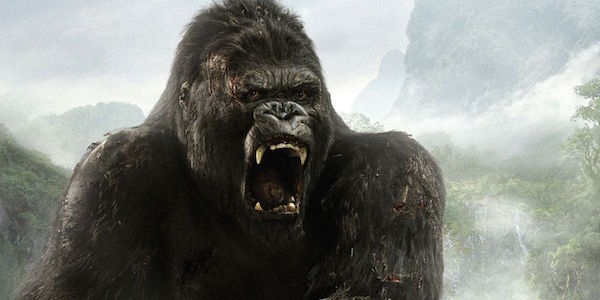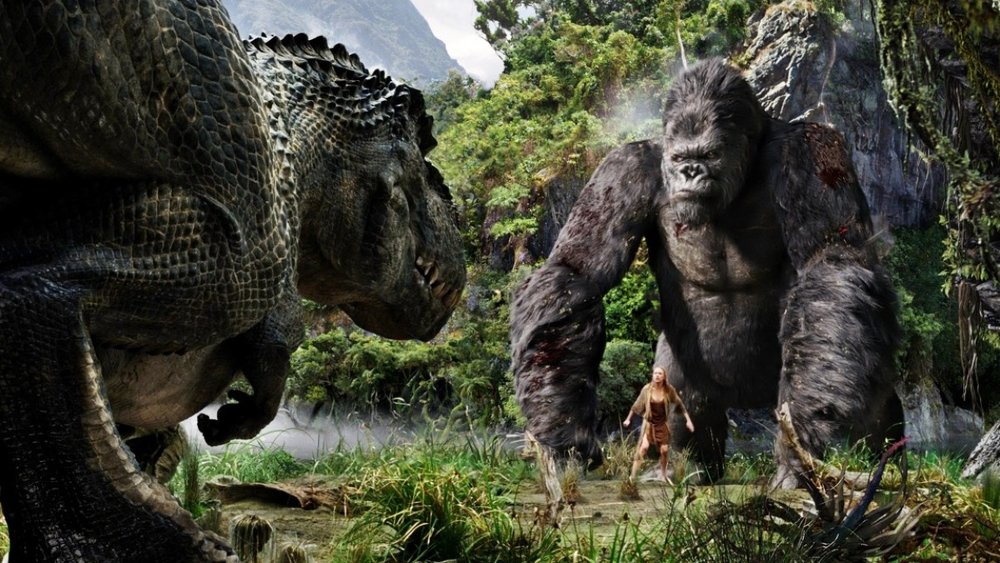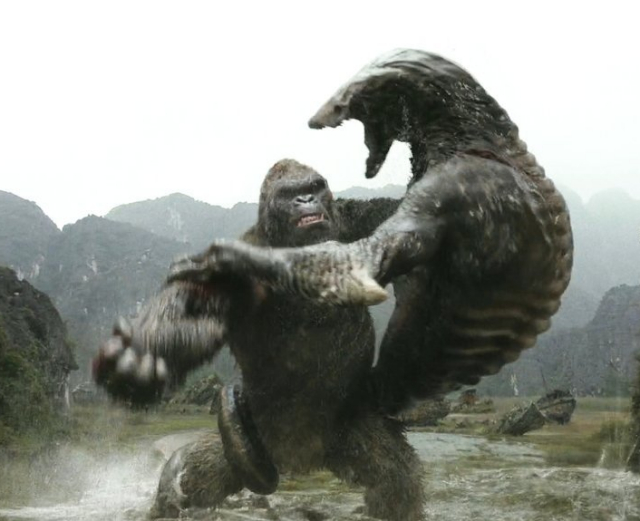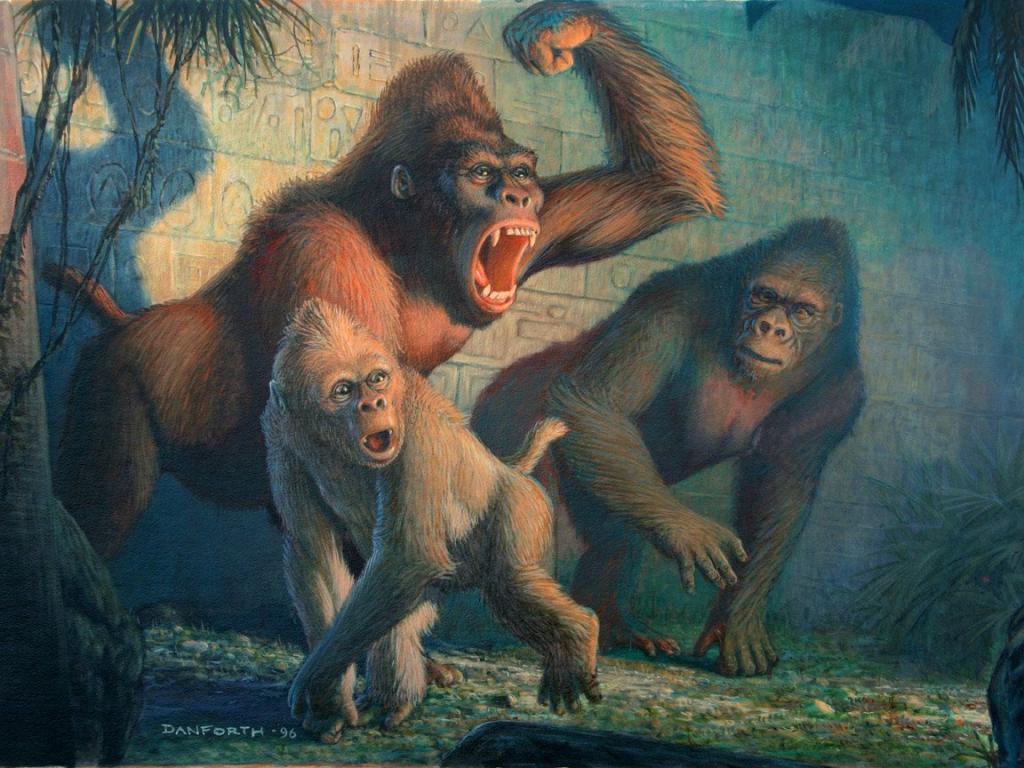1995: A Monster of an Origin Story
Excerpt from Kaiju Kingdom! A Brief History of Massive Movie Monsters, by Gogota “Go” Jira
In the summer of 1995, Universal Studios released
Kong: King of Skull Island[1]. It was the culmination of an ongoing attempt by Universal to bring Kong back to the big screen with the express intent to drum up visitation to the Kongfrontation attraction at the new Universal Studios Florida. Other than the 1992 animated series shared with Godzilla, there’d been no “Kong” productions since the 1970s. It’s also one of the few times that a prequel has been recognized for being as good as, if not better than, the original.
So, let’s talk about it, and the many reasons why it is as popular today as it was when it first aired in 1995.
The Production:
The film had languished in Production Hell through the late ‘80s and into the early ‘90s when MGM’s
Jurassic Park debuted, and revealed what modern CG effects could accomplish. With
Jurassic Park’s popularity, Universal immediately started looking to remake some more of their old monster films, in particular
King Kong and
Creature from The Black Lagoon. “King Kong Returns”, originally envisioned as a standalone film or possibly a reboot, was greenlit in late ’93 with a $50 million budget. Robert Zemeckis was hired to direct, but during pre-production on
The Frighteners for the growing
Tales from the Crypt film franchise, Zemeckis noticed that New Zealand director Peter Jackson was obsessed with
King Kong, and thus hired him as a script consultant, second-unit director, and understudy.
Jackson and Zemeckis ditched the earlier reboot idea and instead developed a prequel story that would both set up, and be a love letter to, the original Universal 1933 classic. It shifted its name to “Kong, the Beginning” and then to
Kong: King of Skull Island. They developed the story of a castaway who, through his experiences on the island, learns to find himself, befriending the natives and learning the true story of Kong. It was a “going native” formula that had proven successful for
Dances with Wolves a few years earlier and had great promise in this case, they felt. The film would also feature an “origin story” for Kong himself, deliberately seeking to “humanize” the great ape, as it were, making him a deeply sympathetic character such that his death in the “original” becomes that much more tragic. A Victorian setting was selected both to set it as a prequel to the original 1933 picture, and because the Victorian era had largely inspired the whole “lost world” archetype, and thus ultimately King Kong.
“The Victorian Era was an age of exploration and discovery, with its brave and clever scientific adventurers going out to all corners of the world and studying and recording what they found. I saw this film as a salute to the old 19th century adventure stories of Robert Louis Stevenson and Joseph Conrad.” – Peter Jackson
One of the first production obstacles was the problematic nature of the Skull Island natives, something that Zemeckis in particular acknowledged as an unfortunate leftover from the original 1933 film. Zemeckis and Jackson agreed to work together to mitigate some of the unfortunate relics of the older screenplay, as well as the inherent Eurocentric bias of the 19th century adventure story tropes it used. They attempted to flesh out and humanize the natives, hiring language and cultural experts to give the natives a Melanesian-inspired culture and language appropriate to a dark-skinned culture in the eastern Indian Ocean.
What, me problematic? (Image source “pintrest.com”)
What emerged was, effectively, an alternate viewpoint to the classic
King Kong story. The idea would be that the original film only told half of the story, and was filtered through the perceptions and biases of the white Americans it starred. This film, though a prequel, would be something subtly subversive to the original rather than just a straight extended flashback, even as it reveled in its classic formula.
Billed as “the film franchise that inspired
Jurassic Park” – at least until MGM lawyers sent Universal a cease-and-desist letter –
Kong: King of Skull Island was filmed in 70mm, mostly on location in Hawaii and the Philippines (incidentally including at a few of the sites where
Jurassic Park filmed). Zemeckis mostly handled the character and animatronic effects shots while Jackson’s second unit filmed lots of the long scenery shots that helped give the film its epic feel. The action is fast paced, with chases through the jungle, massive monster-vs.-monster battles, and epic clashes between the humans. Effects were done in a mix of animatronics by Totally Fun Entertainment and CGI in partnership with Peter Jackson’s new WETA Digital. The dinosaurs, unlike in the 1933 original, are active, warm-blooded, and smart enough to be threatening, which reflected the changes in paleontology since 1933.
Jackson originally envisioned a white British main character in the screenplay, with Liam Neeson specifically identified as a likely star. Denzel Washington, hot off of the success of
Red Tails, was strongly considered, though this would have changed the themes noticeably and likely required another re-write. But in the end, Universal was pushing hard for the popular Tom Cruise, who eventually claimed the lead role and ultimately did a lot of his own stunts. Hallie Berry was then chosen for the native love interest Kai and an unknown actor, Isaac C. Singleton, was chosen as her brother and head warrior Keppa. James Earl Jones was hired to play The Kong Speaker, the de facto leader of The People.
(Image source “cinemablend.com”)
The Story:
The main narrative, set in the Victorian era, details Jack Conner (Cruise), who is a crewman on an American merchant steamer called the
Manchuria. He’s a company man, with scientific interests, who spends most of his time being teased by intellectually inferior shipmates (who make fun of him for reading Darwin) and aggravated by intellectually inferior superiors. In several of these scenes, we see him treat the Indonesian crewmen with a level of subtly condescending parochialism that he clearly sees as polite and courteous but which most modern viewers recognize as “patronizing”. A particular scene is shortly before the attack on the
Manchuria, where his captain reveals that the Indonesian crewmen are acting all jumpy - and orders him to find out (because he doesn't want to talk to the "coolies"). When Jack asks the Indonesians what's going on, one of the older men tells Jack they're nervous because the
Manchuria is going awfully close to the legendary "Island of the Skull" where God dumped all his most terrifying creations. Jack listens with interest at the old man telling his grandfather's story about Skull Island (and then patronizingly tells the man that what he heard from his grandfather is mere superstition, in the manner one would tell a child about the monster in the wardrobe - Jack's interest in the story is merely as an anthropological tidbit.
He soon finds himself a castaway when his ship is destroyed by “something from beneath the waves”, and he soon washes up alone on a mysterious tropical island. He’s struggling to assemble supplies and shelter from the flotsam washing up on the beach when he finds a large sheet of paper and a fountain pen. He names the island Skull Island for the skull-like appearance of the central mountain, and starts drawing it on the large sheet of paper.
Jack starts to explore further into the island, sketching out a map on the paper, and almost immediately is left scrambling for his life as he encounters an impossibly huge great ape (Kong, obviously), who chases him in a primal rage. Jack barely escapes into the forest. He tries to survive on the island, but soon he encounters more of the “prehistoric beasts” who live there, ultimately chased by a pack of ravenous Terror Birds[2].
“Have a look at this li’l beauty!” (Image source “reddit.com”)
Running from the Terror Birds, Jack stumbles across a camp of island natives. Despite some initial misunderstandings and distrust, he is declared “mostly harmless” by the head warrior Keppa (Singleton) and is allowed to live with the tribe, who call themselves “The People”. The Kong Speaker (Jones), the de-facto leader of the tribe, is reluctant to allow the newcomer in, but Keppa speaks for him.
While living with The People, Jack falls instantly in love with a young woman named Kai (Berry), whom he learns is “forbidden from marriage”. He befriends Kai and slowly teaches her some English and she in turn teaches him some of their language (a form of Melanesian). At first Jack thinks fairly little of the “primitive natives” as he describes them in his notebook, and sees them, and the island as a whole, as mere subjects to study. He is unintentionally insensitive to Kai, not aware that he's casually saying things to her and about her people that are rude and condescending. But this mellows as he starts to appreciate the “subtle wisdom” of The People. Even so, he wants to return to “civilization” and starts building a large boat (to the bewilderment of the natives), hoping to share his "discovery" with the world, planning to come back with a proper expedition in order to "shine the light of discovery on it".
Kai takes Jack to some ancient ruins (which Jack adds to his map) and tries to tell him about how her people abandoned the “old ways” because their actions were “at conflict with the island”, but Jack considers this superstition and a “tragedy” that the old city fell and states the old city most likely was destroyed in an earthquake. Jack tells Kai about his plans to tell the world about Skull Island, but is left speechless when she asks what will happen to her people if he does. Jack once again encounters the giant ape with Kai. The ape roars and Jack tries to flee, but Kai stops him. She is overcome with happiness to see the giant and bows to him joyously. She tells Jack that his name is “Kong”, the first time the name is heard on screen. Scared but intrigued, particularly as he discerns that The People revere Kong as “their god” as he sees it, he sets out to scientifically study the “strange beast” from afar.
Kai relates the history of “Great Kong” as she was told by her mother’s mother. This sets up a sub-narrative from Kong’s perspective with flashbacks to centuries prior detailing Kong's birth and how he was orphaned at a young age, leaving him the last of his kind. It begins with Kong’s birth and proceeds through a flowing montage to a pivotal scene with his parents feeding peacefully in a clearing. Little Kong is chasing giant insects, like a kid chasing butterflies. It's a peaceful scene of family togetherness...until Kong stumbles across a giant Tyrannosaur-like beast, which attacks! Kong's father fights the dinosaur in defense of his mate and son, biting the dinosaur savagely on the face, while Kong's mother gets Kong to safety.
Kong's mother keeps her son hidden in a cave, the sounds of her mate fighting the dinosaur echoing in the depths. Eventually, the noises stop and Kong and his mother cautiously emerge from the cave. But the Tyrannosaur, its face covered with Kong's father's blood and some distinctive new scars from Kong’s father’s bite, emerges, roaring, from the mist. It now attempts to eat little Kong, but Kong's mother fights it and manages to drive it off. However, she too is mortally wounded and dies soon after. Little Kong runs to his dead mother and tries in vain to revive her, not yet capable of understanding what is going on. He crawls back to the cave and lies, terrified and alone, as the sounds of the Skull Island night echo around him.
The scene has gone down in Kaiju history as a cinematic tearjerker of monstrous proportions, and plenty of ‘90s kids, myself included, will recall weeping their eyes out at the scene.
The story-within-a-story continues in flowing montage of short set pieces, occasionally narrated in voiceover by Kai, following Kong as he grows up. It’s a hard life, constantly fighting to survive. In one set piece an adolescent Kong is attacked by The People who live there in their big city at this point. Their slash-and-burn farming methods are shown to be slowly killing the island by disrupting the ecological balance.
(Image source “fantasy-animation.org”)
As the flowing montage continues, Kong matures and fights his way to be the “king of the island”, ultimately symbolized by him killing the scar-faced Tyrannosaurus that killed his parents in a brutal melee. He then demolishes the city and attacks The People on sight, who flee him in terror. But this all changes in a set piece where Kong drives away a group of Spanish Conquistadores who seek to pillage the island and enslave The People, which leads the Skull Island natives to revere Kong as their protector. They tie up a screaming young woman in the runs of the city, left as an offering for him. Kong grabs her and carries her away, ending the flashback.
Kong is portrayed as the fair, but ruthless warrior-king of Skull Island, a proud, brutal, but honorable warlord who, through his strength and valor, made this hostile world his kingdom. Jack grows to admire the “beast” in a very “noble savage” kind of way, and is starting to warm more and more to the island. He then joins in a hunt, partnering with Keppa to kill a Hadrosaur-like dinosaur, and thus gets accepted by The Kong Speaker into The People. Keppa and Kai give Jack a necklace made of the teeth of the Hadrosaur he helped kill in symbolic welcome. Seemingly happy for the first time in his life, Jack begins to assimilate peacefully into The People and openly considers “burning his boat” and staying on the island…until, that is, he learns that the reason why Kai cannot be married is that she has been “chosen for Kong.”
Jack assumes that this means that she is to be sacrificed to Kong, and he is deeply disturbed in particular that she enthusiastically supports this plan since she truly believes that it will protect her people. Jack makes a plan to rescue Kai and take her away, but when he intervenes and tries to stop her from the “sacrifice” as she is tied up to the old ruins, he is dragged away, confused and terrified, by Keppa and the warriors of The People as Kong carries off the unresisting Kai, presumably to her death. Almost mute with horror at what he's just witnessed, he quietly calls The Kong Speaker a “monster” and walks away.
Heartbroken and rejected by The People, Jack plans to slip out into the island’s interior in a desperate attempt to rescue Kai. Keppa intercepts him and tries to stop him from going out “beyond the wall”, but their limited understanding of each other’s languages complicates things and Jack heads out as Keppa watches, shaking his head and shedding a tear.
Keppa: You do not understand! She…belongs to Kong! It is…best for him and for us! It was not what you might have thought....
Jack: HOW AM I SUPPOSED TO KNOW WHAT TO THINK WHEN NOBODY TELLS ME THE TRUTH?! Why didn't you tell me that Kai was going to be sacrificed to that, that…monster? Why, Keppa?! Why?! (The awful realisation hits him, as Keppa hangs his head) You never trusted me, did you?
Keppa: No, no, I didn't. I liked you - after a while - but I never trusted you. None of us did. Because, no matter how hard you try, you're not like us - and you never will be.
Jack: (quiet, almost betrayed) Well, I trusted you. And now I'm going to get Kai back – I hope it isn't too late. We can finish this conversation if I come back. (runs off over the wall)
Keppa: Arrogant fool, you do not understand!!
Jack evades the Terror Birds and eventually finds Kong’s cave. He is appalled by the stacks of skeletons he encounters, all dressed in the same ceremonial garb that Kai wore for the ceremony. But instead of finding Kai dead, she is laughing and unafraid, bantering with Kong, who laughs and plays with her.
Kong then smells Jack and nearly charges to kill him for his intrusion, but Kai stops Kong. Jack learns that Kai isn’t a “virgin sacrifice” as he’d assumed, but a “bride”, one of a long line of special young women selected to be Kong’s “Queen”, as it were, platonic companions that help calm the troubled giant and help him to sleep through his nightmares using the ancient songs.
This, of course, sets up why Kong didn't eat Fay Wray’s Ann Darrow, but instead befriended her. She was simply the latest in a long line of companions.
Apparently Giant Apes don’t necessarily prefer blondes.
This moment of peace and clarity is short lived, however, as we now see a huge reptilian beast, identifiable by the distinctive fins on its back as the creature that attacked Jack’s ship in the beginning, emerge from the depths and walk onto the island. The Beast is a hideously ugly mishmash of a newt, a crocodile, a mosasaur and a river dolphin. Two large, sprawling front legs keep the creature low to the ground as it half-walks, half-slithers out of the water. The back half of the beast appears to be almost all tail, with two tiny, useless back legs trailing behind it. Crocodilian scutes line its back, leading to two large fins on its back, almost like bat wings. Its head is superficially dolphin-like, with a swollen-looking forehead (complete with rudimentary blowhole), tiny eyes and a pointed snout, but with lots of large, interlocking crocodile-like teeth. A large tongue lolls maniacally as drool cascades from its mouth.
The People flee in terror as it stomps through the village, eating a few people on the way, and then busts through the wall.
Sort of like this… (Image source “scified.com”)
Kong, smelling the invader, runs after it to defend his island, Jack and Kai running to keep up. Kong and the Beast fight in a massive melee. At one point the Beast has Kong pinned and is about to deliver a killing blow. Kai screams and runs to help, but is struck by the Beast’s tail. Kong manages to overcome and strangle the distracted Beast to death, but Kai is badly injured and dies in Jack's arms.
Kong, claiming Kai's body, turns his back on Jack, snubbing the interloper. When Jack does not move, Kong angrily half-charges him. Realizing the nature of his punishment, Jack falls to his knees and bows deeply to Kong, acknowledging his rule of the island and accepting his banishment. Jack, sad at the rejection, returns to The People, but finds that they’ve burnt his boat. Keppa chases him away, cursing him and his arrogance - and stating that he should have killed him when they first met.
Kong, meanwhile, sadly carries away Kai to his cave, where he reverentially places her body alongside the other skeletons adorned in the ceremonial clothing, presumably his past brides.
Rejected by The People, whose trust he realizes that he betrayed, Jack hobbles together a crude raft and sets out to the north, leaving the island. But he is now at the mercy of the waves, desperately holding onto the Hadrosaur-tooth necklace like a sort of prayer necklace. Just as death seems certain, he is rescued by a whaling ship with a peg-legged Captain. As the crew drag him from the waters, one crewman takes the tooth necklace, snorts derisively, and tosses it into the sea.
(Image source ERBzine)
Jack is last seen recovering in a stateroom, chanting a mantra of “one day, I’ll return and make things right” as he completes his map. We now clearly see that it is the map that Carl Denham, decades later, will discover, sparking the events of the 1933 film.
The Release:
Kong: King of Skull Island debuted in the summer of 1995 to rave reviews. Cruise, Berry, and Singleton were all specifically called out for their acting. Critics and academics applauded the themes of nature-vs-civilization, race, colonialism, and an overt criticism the “White Man’s Burden”. While Universal worked hard to mitigate the racist relics of the original movie, some still found offence with the portrayal of The People, in particular the association of Black people with a giant ape. Others decried it’s “political correctness” and “revisionism” compared to the original narrative. Still others accused the film of advocating bestiality, taking Kai’s “bride” title a little too literally, not to mention overlooking the, um, “logistical challenges” in making such a union happen. Yet such criticism was rare, with most viewers catching on to what the film was trying to say. To this day it’s appreciated for its open rebuttal of the still all-too-common “white savior” tropes.
Kong went on to break $353 million at the international box office and even gained a Best Picture nomination to the shock of many, along with nominations for Cruise and Berry. It would win Cinematography and Special Effects Oscars. The creature effects, though dated and limited due to the technology of the time compared to what we’re used to today, were eye-grabbing enough in 1995 to amaze viewers at the time. In 2002, for a special re-release ahead of Jackson’s
King Kong remake, they took a cue from George Lucas and remastered the effects to take advantage of the improved realism then possible.
Buoyed by
Kong’s success, Universal begin putting their
Creature from The Black Lagoon remake into production. They asked Peter Jackson’s WETA Digital to do the effects and hired Roland Emmerich to write the script, with Jackson set to direct. Peter Jackson would also be selected to do a modernized update to the 1933 original, which would even use a modified version of the original script.
King Kong would be released in 2002…but that’s a story for a future chapter.
The Legacy:
Kong: King of Skull Island, is beloved by fans of Kaiju and is credited with rejuvenating the King Kong brand and paving the way for the many Kaiju films of the 1990s and 2000s and beyond. It’s recognized today as one of the few prequel or origin films that lives up to the rest of the franchise, and many see it as a superior film to the original or the Peter Jackson near shot-for-shot remake.
If Universal’s original purpose of the film was to spur attendance at Universal Studios theme parks, then it succeeded big time, leading to a 14% increase in attendance at U. Studios Florida and a doubling of line wait times for the King Kong Encounter and Kongfrontation attractions in Hollywood and Orlando, respectively. This kicked off the inevitable round of one-upmanship by the various competing parks, to the benefit of us, the visitors.
Kaiju films have always had a core cult audience while the wider audiences’ interest waxes and wanes. And yet, like the original 1933 classic,
Kong: King of Skull Island manages to stay in the hearts of viewers across the demographic spectrum, much like the original
Jurassic Park that arguably inspired it, even as the original
King Kong ultimately inspired the genre that led to
Jurassic Park.
And while I’m clearly a “Gojira Man” myself, I still love this film as one of the greatest Kaiju films of all time. As a kid it amazed me and briefly had me rooting for Kong over Gojira, which didn’t last, cured ultimately by the 1997 Godzilla live action.
The ultimate personal legacy of this film is, for me, the very history that you are reading.
[1] Monstrous Kong-sized hat tip to
@Nathanoraptor,
@Plateosaurus, &
@GrahamB for assisting in this creation.
[2] Chosen as not-so-obvious Velociraptor stand-ins.



